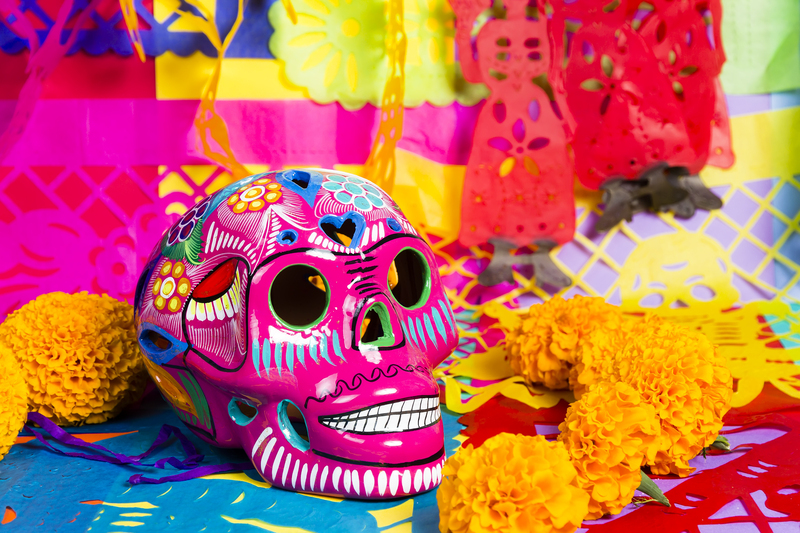The Hidden Language of Flowers: What Your Birth Flower Reveals About You
Posted on 25/08/2025
The Hidden Language of Flowers: What Your Birth Flower Reveals About You
For centuries, flowers have been more than simple decorations or gifts; they have carried profound meanings, influenced traditions, and even conveyed secret messages. The art of floriography--the language of flowers--has reached across cultures and ages, symbolizing love, friendship, and myriad of human emotions. Among the many floral traditions, birth flowers stand out for their personal significance. But what is the hidden language of flowers behind your birth bloom, and what does it reveal about you?
Understanding the Birth Flower Tradition
Birth flowers, much like birthstones, represent the month in which you were born. Each flower is carefully chosen based on its blooming season, its symbolism in folklore, and its emotional resonance. Over time, these flowers have gained meanings and associations that people use to reveal aspects of personality, life's journey, and even romantic compatibility.
By discovering your birth flower, you gain insight into your traits and destiny, as well as a deeper connection to the natural world. The hidden meanings behind these flowers can serve as personal totems, guiding you through life's transitions and challenges.

Birth Flowers by Month and Their Meanings
- January - Carnation
- February - Violet
- March - Daffodil
- April - Daisy
- May - Lily of the Valley
- June - Rose
- July - Larkspur
- August - Gladiolus
- September - Aster
- October - Marigold
- November - Chrysanthemum
- December - Narcissus
The Hidden Language of Each Birth Flower
January: Carnation
Carnation comes in a rainbow of colors, but it universally stands for admiration, love, and distinction. If you were born in January, your birth flower suggests that you are likely resilient and steadfast. Carnations' frilly petals symbolize warmth, optimism, and a relatable, approachable nature.
- Pink carnations: Symbolize motherly love and gratitude
- Red carnations: Denote passion and admiration
- White carnations: Purity and luck
People with the carnation as their birth flower are often seen as loyal friends and supportive family members, unafraid to stand up for what they believe in.
February: Violet
The violet is exquisite and unassuming, standing for modesty, faithfulness, and humility. February-born individuals are reputed to be thoughtful, wise, and spiritual. The violet's gentle aroma is a sign of understated strength and a calm, nurturing soul.
- Faithfulness in friendship and love
- Reserved strength and loyalty
Violets remind us that quiet confidence often outshines outward bravado.
March: Daffodil
As the harbinger of spring, the daffodil signals renewal and new beginnings. Those with a daffodil as a birth flower are likely to possess infectious optimism, bringing sunshine wherever they go. They are often marked by creativity, hope, and a gift for seeing silver linings.
Daffodil people are natural encouragers and like to inspire growth in others.
- Inspiration and encouragement
- Unflagging positivity and hope
April: Daisy
The daisy epitomizes innocence and purity, but also independence and joy. Born in April? Your birth flower describes you as cheerful, honest, and a true friend. You likely bring light and laughter into people's lives, and your optimism is infectious.
- Honesty and loyalty
- Playful and imaginative nature
Daisy people remind us to find delight in the simple pleasures of life.
May: Lily of the Valley
Gracefully bell-shaped, the lily of the valley stands for humility, happiness, and sweetness. People born in May convey a gentle spirit and warm, inviting presence. They are often trusted as confidantes, and their sincerity is their trademark.
- Delicacy and emotional insight
- Renewal and happiness
Traditionally, it is also associated with luck in love and the return of happiness.
June: Rose
The iconic rose has many layers of meaning. While red roses symbolize passionate love, the flower as a whole represents beauty, balance, and strong emotions. If you're a June baby, you may possess a romantic heart, a flair for creativity, and a magnetic personality.
- Red rose: Passion and love
- White rose: Innocence and youth
- Yellow rose: Friendship and joy
June-born individuals are complex, balancing strength of character with deep compassion.
July: Larkspur
The larkspur, with its majestic spikes of color, symbolizes lightness, levity, and positivity. If your birth flower is the larkspur, you likely carry a playful spirit and an open heart. You're expressive, empathetic, and draw friends close with your honest enthusiasm.
- Joy and devotion
- Sparkling personality and friendships
August: Gladiolus
The gladiolus is a striking flower that reflects strength, integrity, and moral character. If you're born in August, your inner fortitude and commitment to values define you. Gladiolus folks are known for pursuing their goals with determination and inspiring others by example.
- Remembrance and sincerity
- Leadership and independence
Gladiolus people remind us to stand tall and remain true to ourselves in all circumstances.
September: Aster
The aster is elegantly star-shaped, symbolizing wisdom, faith, and valor. If this is your birth flower, you might be a thoughtful, dependable friend who values knowledge and fairness above all. Astute and loyal, aster people are the ones others turn to for sage advice.
- Elegance and patience
- Trustworthiness and intellect
October: Marigold
Vivid and bold, the marigold stands for creativity, passion, and warmth. Those born in October are known to possess vibrant personalities, strong willpower, and a zest for life. Their enthusiasm is contagious, and their capacity for empathy is deep.
- Cheerfulness and perseverance
- Resilience in adversity
Marigold individuals are inspiring leaders and compassionate companions.
November: Chrysanthemum
Chrysanthemums, or "mums," indicate friendship, joy, and abundance. With this unique birth flower, November-born people radiate trustworthiness, and their warmth draws people close. Mums also symbolize longevity and well wishes, making them perfect for those who uplift and support others.
- Optimism and loyalty
- Cheer and confidence
December: Narcissus (Paperwhite)
The narcissus is a symbol of hope, prosperity, and unconditional love. December individuals often carry a graceful aura, shining a light in the lives of others. Their nurturing spirit is matched with a drive to seek beauty and happiness everywhere.
- Sincerity and ambition
- Faithfulness and optimism
How Your Birth Flower Reflects Your Personality
Your birth flower is more than a symbol--it is a subtle reflection of your spirit. Just as astrology or numerology draw links between your birthdate and your inner character, the hidden language of flowers translates your essence into glorious color and scent.
For instance, if you connect with the independent, joyful energy of a daisy, you may find that your relationships are based on honesty and laughter. If the elegant wisdom of the aster resonates with you, you are likely the wise counsel in your circle.
The Adaptability of Birth Flower Meanings
While traditional birth flower meanings provide a foundation, it's important to consider personal and cultural variations:
- Color variations: Each flower comes in multiple hues, each carrying additional meaning. For example, different rose colors evoke passion, friendship, or purity.
- Regional options: Certain countries and cultures select alternative flowers for each month based on local flora.
- Individual resonance: You may find a powerful connection to your birth flower's qualities, or feel drawn to another that better represents your journey.
Allow the hidden language of flowers to be a living tradition, adapting and growing with you over time.
Ways to Honor and Incorporate Your Birth Flower
Now that you understand the unique meaning of your birth flower, you might wish to infuse its symbolism into your daily life. Here are some creative ways to do so:
- Floral jewelry: Choose pieces featuring your birth flower as a unique and personal accessory.
- Home decor: Incorporate fresh or dried birth flowers into wreaths, bouquets, or framed art for a personalized touch.
- Gardening: Grow your birth flower in your garden or on your windowsill, creating a living connection to your identity.
- Gifting: Celebrate loved ones with bouquets of their special birth flowers, thoughtfully sending messages through blossoms.
- Journaling: Write about how your birth flower's qualities appear in your daily thoughts and actions for self-reflection and growth.
By connecting with your birth flower, you strengthen your bond with nature and celebrate your individuality.
Fun Facts: The Global Language of Flowers
- Victorian secrets: In Victorian England, bouquets conveyed coded messages of love and intrigue--knowing the hidden language of flowers was a valued skill.
- Japanese "hanakotoba": In Japan, the art of flower symbolism ("hanakotoba") is still part of daily life, used to express emotions and intentions subtly.
- Ancient Greeks and Romans: Associated flowers with gods and goddesses, giving blooms powerful mythological meanings.
The birth flower tradition stretches across continents, woven through history and the very heart of civilization.

The Lasting Power of the Birth Flower Connection
Whether you believe deeply in the hidden language of flowers or see your birth flower as a charming touchstone, there is magic in the enduring power of these living symbols. They teach us that every individual is unique, carrying qualities as singular as petals on a bloom.
By embracing your personal birth flower, you can:
- Strengthen your self-understanding
- Enhance your daily mindfulness practice
- Deepen connections with friends and loved ones
- Add layers of meaning to personal milestones and gifts
Conclusion: Discover Your Floral Identity
Flowers are the poetry of the earth, and your birth flower tells a story like no other. The next time you see a daffodil blooming in the early spring or a marigold glowing in autumn sunlight, remember the symbolism behind these beautiful creations--and the secrets they reveal about you.
Let the hidden language of flowers enrich your life, inspire your heart, and help you uncover your truest self.
Latest Posts
The Hidden Language of Flowers: What Your Birth Flower Reveals About You
Symbolism in Bloom: The Colorful Messages of Peony Flowers
Dive Deeper into Tulips with These 7 Unseen Facts





